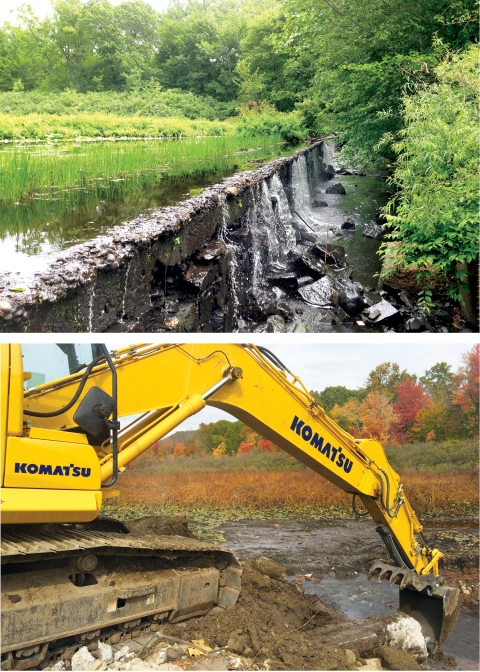Having a good estimate of nature’s value allows communities to make informed land management decisions and effectively advocate for land protection.
That’s why more and more experts are quantifying the economic worth ofnature’s benefits. Research shows that land conservation has an impressive economic value by boosting local economies through tourism and jobs, saving money on health care, filtering drinking water, providing natural disaster mitigation, and more.
Health: The Benefits and Savings of Getting Outside
Nature is good for you — from reducing stress and depression to improving cardiovascular health, research shows that nature can help people be healthier and spend less on medical costs. Access to natural areas such as parks and greenways helps ensure that as many people as possible can benefit from nature’s medicine.
Improving Health with a Greenway in Alabama
Obesity and obesity-related illnesses cause serious health problems for adults and children in the United States and cost an estimated $192 billion per year in health care. Alabama has the second highest rate of obesity in the nation. One community’s answer to the problem was creating a new trail system in Jefferson County. Through a grant from the Centers for Disease Control and Prevention, the accredited Freshwater Land Trust (AL) is developing a 750-mile trail system that links communities throughout the county, including Birmingham, the state’s most populous city. Many of these trails are located in neighborhoods with the highest rates of diabetes, high blood pressure, and other obesity related illnesses.
The urban trail system in Jefferson County, Alabama, will save residents $21 million to $43 million in medical costs annually!
Clean Water: The Price of a Healthy Drink
Forests, grasslands, and wetlands help filter stormwater and recharge groundwater. By protecting the lands around water sources, we can provide clean drinking water to people and reduce water treatment costs.
New York City’s Clean Water Secret is Land Protection
New York City’s water supply system is a model for other cities. Using surface water reservoirs, the system provides 1.2 billion gallons of clean drinking water daily to 9 million people. And land protection is the key to its success, because the protected lands surrounding the reservoirs act as natural filters for the clean water that pours out of the city’s faucets. A coordinated effort among government agencies, nonprofits, and communities helped to protect more than 100,000 acres of forests and other natural habitats across the city’s watersheds. Local land groups, like the Catskill Center and the Watershed Agricultural Council, help secure easements on lands around drinking water reservoirs, preserving natural habitats while reducing pollutants that impact water quality.
New York City saves about $7 billion in water treatment infrastructure costs by drawing its drinking water from protected watersheds.
Local Economies: How Nature Supports Communities
How can land and water protection boost local economies? Experts are connecting the dots using economic impact studies that identify the value nature provides in the form of jobs, recreation, tourism, increased home prices, and much more.
In Alaska, Livelihoods Depend on Nature.
Salmon and bears are some of the iconic wildlife of Alaska. The Matanuska-Susitna Borough (Mat-Su), is the fastest developing region in the state. To ensure that salmon, bears, and other wildlife remain on the landscape, strategic habitat conservation is necessary. To protect the habitat that fish, wildlife, and people depend on, the U.S. Fish and Wildlife Service — Coastal Program works with the accredited Great Land Trust (AK) to prioritize landscapes and waterways for protection. This partnership collaborated with the tribal corporation Eklutna, Inc. — the largest private landowner in Anchorage — to protect 4,800 acres that support vital habitat for five species of salmon. The area also connects two popular wildlife and recreational areas that are critical for subsistence hunting and recreational and commercial salmon fishing in the Mat-Su.
Spending on sport fishing supports as many as 1,900 jobs and generates as much as $64 million in income for workers in the Mat-Su Borough.
Storm Protection: Natural Defenses Against Flooding and Sea-Level Rise
Land protection is a crucial strategy for mitigating the impacts of climate change climate change
Climate change includes both global warming driven by human-induced emissions of greenhouse gases and the resulting large-scale shifts in weather patterns. Though there have been previous periods of climatic change, since the mid-20th century humans have had an unprecedented impact on Earth's climate system and caused change on a global scale.
Learn more about climate change . Marshes, wetlands, forests, mangroves, and oyster reefs can reduce flooding and erosion caused by storms and defend coastal communities from sea-level rise. Protecting natural areas saves lives and property and reduces the need for expensive infrastructure such as flood walls and levees.
After Hurricane Sandy, Making the Coast More Resilient in Connecticut
For years, the community of Woodbridge in New Haven, CT, endured persistent flooding during heavy rain and storms. Residents recalled canoeing down flooded streets and repairing damaged homes. The destruction caused by Hurricane Sandy highlighted a need to conserve natural defenses against flooding. Flood relief came to Woodbridge with the removal of Pond Lily Dam, which was funded by Hurricane Sandy disaster relief efforts. Aging dams such as Pond Lily can pose a risk to nearby communities by increasing flood levels during storms and being prone to breaching. The Coastal Program worked with numerous partners, including the New Haven Land Trust (CT), to remove the dam and restore natural stream functions. Removing the dam made this flood-prone area a safer place.
A similar type of dam removed in Taunton, MA, saved an estimated $1.5 million in emergency response costs caused by flooding.
Sustainable Fisheries: Protecting Local Fishing Traditions
Protecting marine habitats helps safeguard species diversity, improve fish populations, and foster resiliency in the face of environmental changes — while balancing fishing and recreational uses.
Community-Based Subsistence Fishing in Hawai’i
The community of Ha’ena had always operated on a “catch what you need” ethic, passed from generation to generation. But when fish catches dropped, they knew something had to change. To address overfishing and preserve cultural traditions, the community developed a 3,583-acre subsistence fishing area to protect coral reefs, fisheries, and fishing traditions. The Coastal Program helped the community develop a management plan for monitoring the fishing area, which now serves as a model for other communities.
From land trusts to private landowners, a variety of organizations and individuals are working to protect land and waters for many different reasons. Natural habitats — whether public or private, undeveloped or working landscapes — provide numerous benefits to people, including significant economic value for strong communities.
Coral reef ecosystems in Hawai'i generate an estimated $360 million a year for the local economy, which includes recreation and fisheries.
Investing in Nature Makes Good Financial Sense
Find out more — see references and additional statistics about the economic benefits of nature at: www.lta.org/investinnature








